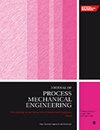含有纳米流体的空腔中 U 形障碍物的位置和尺寸对热性能的影响
IF 2.2
4区 工程技术
Q2 ENGINEERING, MECHANICAL
Proceedings of the Institution of Mechanical Engineers, Part E: Journal of Process Mechanical Engineering
Pub Date : 2024-07-25
DOI:10.1177/09544089241263706
引用次数: 0
摘要
这项工作的目的是研究在长度为 lr = 0.6 H、高度为 hr = 0.4 H、厚度为 wr = 0.2 H 的二维长度为 L、高度为 H 的正方形空腔内填充金刚石水纳米流体(固体体积分数范围为 0.05)的 U 形障碍物位置的影响。空腔底壁温度恒定(Th)。两个侧壁冷却到恒温 Tf,空腔上壁为绝热。研究了四种情况下障碍物与热壁的位置关系:第一种情况下,障碍物位于垂直的左侧壁上;第二种情况下,障碍物位于上部(靠着热壁);第三种情况下,障碍物位于垂直的右侧壁上;第四种情况下,障碍物位于热壁上。此外,还研究了第四种情况下障碍物的厚度、长度和宽度等尺寸对空腔内热交换的影响。在层流和稳定流状态下,在雷利数等于 103 和 105 时得出了数值结果。研究结果表明,在四种情况下,增加瑞利数对传热系数都有影响。我们发现,与所研究的情况相比,第四种情况下的障碍物位置的热交换效果最好,与第一种情况、第二种情况和第三种情况的热交换效果分别相差 8.8%、11% 和 8.9%。我们还注意到,障碍物厚度、长度和高度的增加会影响第四种情况下的热交换。本文章由计算机程序翻译,如有差异,请以英文原文为准。
Influence of the position and dimensions of a U-shaped obstacle in a cavity containing a nanofluid on the thermal performances
The aim of this work is to study the effect of the position of an obstacle in the U-shaped with length lr = 0.6 H and height hr = 0.4 H, thickness wr = 0.2 H located inside a square cavity of two-dimensional length L and height H filled with a diamond–water nanofluid (solid volume fraction in the range of 0.05). The bottom wall of the cavity is brought to a constant hot temperature ( Th ). The two side walls are cooled to a constant temperature Tf , and the upper wall of the cavity is adiabatic. The position of the obstacle in relation to the hot wall was studied in four cases: in the first case, the obstacle is placed on the vertical left side wall, the obstacle is placed on the upper in case 2, (against a hot wall), the obstacle is placed on the vertical right side wall in the case three, and the fourth case the obstacle is placed on the hot wall. The effect of the obstacle dimensions, such as its thickness, length, and width in the fourth case, on heat exchange inside the cavity was also studied. Numerical results were developed for Rayleigh numbers equal to 103 and 105 for the laminar and steady flow regime. According to the results obtained from the study, the effect of increasing the Rayleigh number on the heat transfer coefficient was observed in the four cases. We found that the position of the obstacle in the fourth case gives the best heat exchange compared to the cases studied, with a difference of 8.8%, 11%, and 8.9% for the first case, the second case, and the third case, respectively. We also noticed that an increase in the thickness, length, and height of the obstacle affects the heat exchange in the fourth case.
求助全文
通过发布文献求助,成功后即可免费获取论文全文。
去求助
来源期刊
CiteScore
3.80
自引率
16.70%
发文量
370
审稿时长
6 months
期刊介绍:
The Journal of Process Mechanical Engineering publishes high-quality, peer-reviewed papers covering a broad area of mechanical engineering activities associated with the design and operation of process equipment.

 求助内容:
求助内容: 应助结果提醒方式:
应助结果提醒方式:


